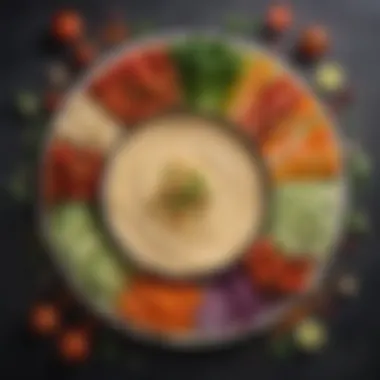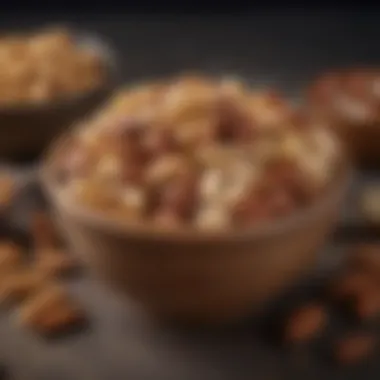Smart Snack Choices for Diabetics: Healthy Options


Intro
Understanding what snacks are beneficial begins with a focus on nutrient-dense options. This means foods that are rich in vitamins, minerals, and fiber while being low in added sugars and unhealthy fats. Nutrition plays a critical role in diabetes management and can help stabilize blood sugar levels effectively.
In the following sections, we will explore several snack ideas that align with dietary recommendations for diabetics. Each suggestion will include details about the ingredients, nutritional value, and pairing ideas to enhance flavor without compromising health.
Recipe Overview
Recipe Name and Description
One excellent snack option is Greek Yogurt with Berries and Nuts. This simple dish combines creamy yogurt with antioxidant-rich berries and a handful of nuts for added healthy fats and protein. It is quick to prepare and makes a nutritious snack that can keep one feeling full between meals.
Cuisine Type
The dish draws influences from Mediterranean cuisine, known for its emphasis on fresh, wholesome ingredients. It perfectly aligns with current dietary guidance for managing diabetes.
Ingredients List
Detailed Ingredient Breakdown
- Plain Greek Yogurt (unsweetened): Ideal for low sugar content and high protein.
- Mixed Berries (strawberries, blueberries, or raspberries): These provide antioxidants and fiber while being relatively low in sugar.
- Nuts (almonds or walnuts): Excellent source of healthy fats and protein, which help manage satiety.
- Chia Seeds (optional): A great source of omega-3 fatty acids and can add more fiber.
Substitutions for Dietary Needs
- Dairy-Free Option: Substitute Greek yogurt with coconut yogurt or almond yogurt.
- Nut-Free Alternative: Replace nuts with seeds, such as pumpkin or sunflower seeds, for crunch.
- Berry Alternatives: Use low-sugar fruits, like slices of kiwi or peaches, if preferred.
In the following sections, we will delve deeper into other snack options suitable for diabetics and provide insights on their specific nutritional benefits.
Understanding Diabetes and Nutrition
Understanding the relationship between diabetes and nutrition is essential for controlling this condition. Diabetes affects how the body processes sugar, necessitating a focus on management techniques that include diet. What you eat plays a major role in blood sugar levels, making it crucial to select foods wisely. A balanced diet not only helps maintain glucose levels but also promotes overall health.
A clear grasp of nutrition helps individuals with diabetes make informed decisions. By recognizing the impact of various foods on their condition, they can avoid spikes in blood sugar. Moreover, this knowledge allows for better meal planning, which can ease the burden of daily management.
Focusing on nutrient-dense foods is advantageous. These foods can provide essential vitamins and minerals while supporting blood sugar control. As individuals explore their dietary options, it is often useful to look for foods that are lower in refined sugars and high in fiber. This results in slower absorption of glucose, contributing to a stable energy level throughout the day.
"Nutrition plays a critical role in managing diabetes, influencing both physical health and quality of life."
The Role of Diet in Diabetes Management
Diet is a cornerstone of diabetes management. A properly balanced diet aids in maintaining consistent blood sugar levels. This balance is achieved by integrating foods that have a low glycemic index. Foods low on this index release sugar slowly into the bloodstream, which prevents sudden spikes. Good examples include whole grains, legumes, and most non-starchy vegetables.
Additionally, incorporating a variety of nutrients is vital. Carbohydrates are often the main focus, but protein and healthy fats are equally important. Lean meats, fish, nuts, and seeds provide essential nutrients while helping to reduce hunger.
Another critical aspect is meal timing. Regular meal intervals help control blood sugar levels. Skipping meals can lead to fluctuations, making it harder to manage diabetes effectively. Hence, establishing a consistent eating schedule supports better glucose management.
Nutritional Guidelines for Diabetics
Understanding specific nutritional guidelines is valuable for anyone managing diabetes. The following points highlight key principles:
- Focus on Whole Foods: Prioritize fruits, vegetables, protein, and whole grains. These foods offer necessary nutrients without excessive sugars.
- Control Portion Sizes: Being mindful of portion sizes helps in avoiding overeating. It also aids in managing carbohydrate intake effectively.
- Read Nutrition Labels: Understanding food labels allows for better choices. Check for total carbohydrates, sugars, and fiber content to make informed selections.
- Stay Hydrated: Water should be the main beverage choice. Drinking sufficient fluid helps with digestion and appetite control.
Overall, following these guidelines can lead to better blood sugar control and improved health outcomes. Therefore, a structured approach to nutrition can make a significant difference in managing diabetes.
Identifying Healthy Snack Options
In managing diabetes, making informed food choices is essential. Identifying healthy snack options can have a significant impact on blood sugar control and overall well-being. This section delves into the elements that persist as beneficial when selecting snacks. Focus will be given to key nutrients, portion control, and the effects these have on diabetes management.
Key Nutrients to Look For
When seeking out snacks, it is important to prioritize certain key nutrients that are particularly beneficial for diabetics. First, fiber comes to mind. Foods rich in fiber help slow glucose absorption, thus preventing spikes in blood sugar levels. Sources of fiber include fruits with edible skins, vegetables, legumes such as chickpeas, and whole grains like oats.
Next is protein, which enhances satiety. Including protein in snacks can reduce hunger and may minimize the urge to snack again too soon. Good protein sources include Greek yogurt, cottage cheese, nuts, and seeds.
Healthy fats also play a role. Foods high in monounsaturated fats, like avocado and almonds, can support heart health, which is crucial for diabetics. By being mindful of these nutrients, individuals can make conscious decisions that suit their dietary needs.
Summary: Focus on snacks high in fiber, protein, and healthy fats for better blood sugar management.
The Importance of Portion Control
Portion control is another cornerstone of effective snack management for diabetics. Regardless of how healthy a snack may be, overconsumption can lead to increased blood glucose readings. Understanding proper serving sizes is key.
Using measuring tools or visual references can be helpful. For example, a serving of nuts is typically one small handful, or about 28 grams. This small adjustment can significantly affect overall carbohydrate intake.
Moreover, employing mindful eating techniques can enhance awareness of food choices. Pay attention to hunger cues and aim to eat snacks when truly needed. This approach reduces the likelihood of mindless eating, which can often lead to unintentional overindulgence.


Ultimately, combining nutrient-rich snacks with appropriate portions creates a balanced approach. This thoughtful methodology empowers individuals to satisfy their cravings without compromising their health.
Fruits and Vegetables as Snacks
Fruits and vegetables are fundamental components in a healthy diet, particularly for individuals managing diabetes. Their low-calorie count, high nutrient density, and overall health benefits make them ideal snack options. Understanding the role of these foods in diabetes management can empower individuals to make better choices. The consumption of fruits and vegetables can help stabilize blood sugar levels while providing essential vitamins and minerals that promote overall health.
Incorporating fruits and vegetables into snacks has multiple benefits. First, they are packed with fiber, which can slow down the absorption of sugar, reducing spikes in blood glucose levels. Second, they are rich in antioxidants and other nutrients that can improve heart health – a crucial consideration for those with diabetes. Moreover, their natural sweetness can satisfy cravings without the need for unhealthy added sugars.
However, while fruits and vegetables can be beneficial, it’s important to also consider glycemic index (GI). Some fruits and vegetables can have higher GI values, meaning they may affect blood sugar levels more significantly. Portion control and understanding which varieties are best suited for a diabetic diet is crucial for maintaining stable blood sugar levels. Choosing snacks wisely can make a significant difference.
Low-Glycemic Fruits
When choosing fruits as snacks, individuals with diabetes can benefit from opting for low-glycemic options. These fruits typically cause a slower, more gradual rise in blood sugar levels, making them easier to incorporate into a diabetic meal plan. Examples include berries such as strawberries, blueberries, and blackberries, which are not only low in sugar but also high in fiber.
Some additional low-glycemic fruits include:
- Cherries: Loaded with antioxidants and vitamins.
- Apples: A good source of fiber, especially when the skin is consumed.
- Pears: Another high-fiber option with a low GI.
These fruits can be enjoyed on their own or added to a variety of dishes for flavor and nutrition. They can be sliced and served with nut butter or mixed into a Greek yogurt for a satisfying snack that balances protein and carbohydrates.
Fiber-Rich Vegetables
Vegetables are incredibly valuable for snacking, especially fiber-rich options. High-fiber vegetables help in feeling full, which can prevent overeating. Additionally, fiber aids in digestion and can play a vital role in maintaining stable blood sugar levels. Several vegetables stand out for their high fiber content, making them excellent snack choices for those managing diabetes.
Some fiber-rich vegetables include:
- Broccoli: Offers a variety of vitamins; it's delicious either raw or steamed.
- Carrots: Crunchy and naturally sweet, making them a perfect portable snack.
- Celery: Low-calorie and high in water content, ideal for snacking with dips like hummus.
Pairing these vegetables with healthy dips can create a well-rounded, nutrient-dense snack. They are satisfying while providing essential nutrients without elevated blood glucose levels.
A balanced intake of fruits and vegetables is critical for maintaining overall health while managing diabetes. Always aim to vary choices to maximize nutrient absorption.
Protein-Based Snacks
In the context of diabetes management, incorporating protein-based snacks can be essential. Protein helps in stabilizing blood sugar levels and keeps hunger at bay. It is a macronutrient that slows the absorption of carbohydrates, preventing spikes in blood glucose. Additionally, the inclusion of protein can encourage satiety, leading to easier portion control and reduced overall calorie consumption.
When selecting protein-rich snacks, it is important to choose whole food sources. Look for varieties that are low in added sugars and unhealthy fats. Consider the following options:
- Almonds: Provide healthy fats, fiber, and protein. They can keep you satisfied between meals.
- Pumpkin seeds: These are not only rich in protein but also provide essential minerals.
- Sunflower seeds: They offer a good balance of healthy fats and protein, making them a quick snack choice.
Nuts and Seeds
Nuts and seeds deserve special attention as protein-based snacks for diabetics. They are nutrient-dense and packed with healthy fats and fiber, both of which are beneficial for blood sugar control. A handful of almonds, walnuts, or chia seeds can deliver a powerful punch of nutrients. They can improve heart health too, which is particularly important for diabetics who may face increased cardiovascular risks.
In terms of portion size, moderation is key. Consume nuts and seeds in small quantities, as they are calorie-dense. Another thing to keep in mind is the potential for added salts and sugars in some packaged varieties. Always opt for raw or dry-roasted options without added ingredients.
Greek Yogurt and Cottage Cheese
Greek yogurt and cottage cheese are excellent protein snacks that can serve well in a diabetic diet. Both options are rich in protein and range between moderate to low in carbohydrates. Greek yogurt, in particular, is also a good source of probiotics, which can aid digestion and improve gut health.
When choosing Greek yogurt, look for plain varieties with no added sugars. You can enhance their flavor by adding some fresh berries or a sprinkle of cinnamon, which can provide additional health benefits without compromising blood sugar levels.
Cottage cheese can be taken on its own or used as a base for other snacks. Pair it with sliced fruits or vegetables to increase fiber intake, promoting an overall balanced snack. Keep in mind that portion size matters; a serving of about half a cup is typically sufficient to gain health benefits without excess calories.
Research indicates that high-protein snacks can help manage blood sugar levels, making them a favorable choice for individuals with diabetes.
By opting for protein-based snacks, those managing diabetes can have satisfying options that support their dietary needs while addressing hunger effectively. This approach aligns with a holistic view of nutrition that emphasizes balance and health.
Whole Grains and Snacks
Whole grains are a critical aspect of a healthy diet, especially for individuals managing diabetes. They are complex carbohydrates that provide essential nutrients, including fiber, vitamins, and minerals. Choosing whole grains can help stabilize blood sugar levels, improve digestion, and reduce the risk of heart disease. This section delves into why whole grains should be included in snack options for diabetics.
Whole grains have a lower glycemic index compared to refined grains. This means that they can cause a slower and more gradual increase in blood sugar levels. Incorporating whole grains into snacks can lead to better blood sugar control. In addition, the fiber in whole grains promotes a feeling of fullness, which can help manage cravings and prevent overeating. A diet rich in whole grains also supports overall health due to their nutrient density.
When selecting whole grain options, it is important to look for products that are labeled as 100% whole grain. This ensures that the nutrients and fiber are retained. Additionally, be wary of added sugars and artificial ingredients often found in processed whole grain snacks.
Choosing Whole Grain Options
When choosing whole grain products, first consider the ingredient list. Look for whole grain as the first ingredient. Common examples include whole wheat, brown rice, oats, and quinoa. By opting for products labeled as whole grain, you ensure you are getting the full nutritional benefits.
Next, pay attention to portion size. Whole grains are nutritious, but they can be high in calories. Try balancing your plate with lean proteins and healthy fats when snacking. This will provide a more satisfying and filling option.
Some popular whole grain snacks include:
- Whole grain crackers
- Popcorn (preferably air-popped)
- Whole grain tortillas
- Oatmeal or overnight oats with a low glycemic fruit


Snack Ideas with Brown Rice and Quinoa
Brown rice and quinoa are versatile whole grains that can be easily integrated into snacks. Both provide a good source of protein and fiber, making them ideal for blood sugar control.
Brown Rice
Brown rice can be used in various snack recipes. One simple idea is to make a rice bowl with vegetables and a protein source, like grilled chicken or tofu. You can also prepare rice cakes topped with avocado or hummus. This makes for a satisfying and nutritious option.
Quinoa
Quinoa is a remarkable grain that is both gluten-free and high in protein. It can be used to create nutritious snacks like quinoa salad, where you mix cooked quinoa with vegetables, herbs, and a splash of lemon juice. Another idea is to prepare quinoa bites by combining cooked quinoa with spices, forming into small cakes, and baking them. These can be enjoyed as a snack or during a meal.
Incorporating whole grains like brown rice and quinoa into your snacks not only boosts nutritional content but also supports blood sugar management effectively.
Dairy Alternatives for Diabetics
Dairy alternatives play a vital role in the diet of diabetics. Many individuals with diabetes either choose to avoid dairy or cannot tolerate it due to lactose intolerance. These alternatives can provide similar textures and flavors found in traditional dairy products, which helps to maintain variety in one's diet. Choosing the right dairy alternatives is important for managing blood sugar levels, ensuring proper nutrition and overall health. They often have lower glycemic indices compared to conventional dairy, which may help prevent blood sugar spikes.
Moreover, dairy alternatives are available in various forms including nut, soy, and coconut-based products. These options also commonly contain less saturated fat compared to cow's milk, making them heart-healthier substitutes. It is crucial for diabetics to check the labels on these products as some may contain added sugars or preservatives which can affect blood sugar control.
Plant-Based Dairy Products
Plant-based dairy products are derived from sources like nuts, soy, and grains. Common options include almond milk, soy milk, and coconut yogurt. Each product brings distinct flavors and nutritional profiles. For example, soy milk is a good source of protein whereas almond milk is lower in calories and carbohydrates.
When selecting plant-based dairy products, it is wise to choose options that are unsweetened. This minimizes the risk of excessive sugar intake, which is critical for managing diabetes. Additionally, some brands fortify their products with vitamins and minerals, including calcium and vitamin D, which can help meet daily nutritional requirements.
In terms of taste and application, these alternatives can be seamlessly incorporated into a range of recipes, from smoothies to baking. Their versatility makes them ideal for those looking to lower insulin resistance while enjoying delicious meals and snacks.
Incorporating Dairy Alternatives into Snacks
Incorporating dairy alternatives into snacks can be both easy and satisfying. For instance, almond or soy milk can be blended into smoothies with low glycemic fruits such as berries. This creates a nutrient-rich beverage that is both refreshing and filling.
Another simple idea is to substitute yogurt with coconut yogurt when making parfaits. Layering the yogurt with high-fiber fruits and nuts creates a balanced snack. It is essential to combine these alternatives with high-protein or high-fiber foods to optimize blood sugar control.
Here are a few easy ideas for incorporating dairy alternatives:
- Smoothies: Blend unsweetened almond milk with leafy greens, fruits, and seeds.
- Yogurt Parfaits: Layer coconut yogurt with berries and a sprinkle of chia seeds.
- Savory Dips: Use cashew cheese as a dip with vegetable sticks.
By making small adjustments, one can enjoy a variety of snacks that support a diabetic-friendly lifestyle. Always read the food labels to ensure that snack options align with personal dietary needs.
Balancing Snack Combinations
Balancing snack combinations is crucial for individuals managing diabetes. It provides a practical way to maintain steady blood sugar levels while satisfying hunger. By focusing on the ideal composition of nutrients, diabetics can enjoy snacks that not only taste good but also support their health. The right balance between protein, carbohydrates, and healthy fats can lead to increased satiety, sustained energy, and enhanced overall well-being.
Why Balance Matters
A well-balanced snack can prevent the spikes and drops in blood sugar that are challenging for diabetics. When snacks contain a variety of nutrients, they may help stabilize blood glucose levels. This stability is important, as fluctuating sugar levels can affect mood, concentration, and energy levels. Understanding how to mix and match different food components allows for healthier choices with added taste.
Combining Protein and Carbohydrates
Combining protein and carbohydrates is a strategic method to optimize diabetic snacks. Protein helps to slow down the digestion of carbohydrates, leading to gradual glucose absorption. For example, when pairing whole grain crackers with hummus, the protein in hummus balances the carbs in crackers. This balance can keep hunger at bay longer and help avoid energy crashes.
Some effective combinations include:
- Peanut butter and apple slices
- Greek yogurt with berries
- Cottage cheese and whole grain toast
Each of these combinations offers a rich source of nutrients while keeping blood sugar levels steady. It is helpful to remember that not all carbohydrates are equal. Focusing on complex carbohydrates, such as whole grains and legumes, can contribute to a healthier snack option.
The Role of Healthy Fats
Healthy fats play an integral role in achieving balanced snacks as well. These fats are essential for hormonal balance and can also provide a sense of fullness that is beneficial for portion control. Some examples of healthy fats include avocados, nuts, and olive oil. Adding a small amount of healthy fat can enhance the flavor and texture of snacks, making them more enjoyable and satisfying.
For instance, drizzling olive oil over roasted vegetables adds both taste and nutritional value. Similarly, including nuts in trail mixes or salad can provide crunch while contributing essential nutrients. It is important, however, to keep portion sizes in mind as fat is calorie-dense.
The integration of protein, carbohydrates, and healthy fats creates a well-rounded snack that supports blood sugar management.
Preparing Snacks at Home
Preparing snacks at home is not just a trend; it is a vital practice for individuals managing diabetes. This approach offers several advantages that are particularly significant for blood sugar control. By making snacks at home, one can select ingredients that align with dietary goals. This means choosing whole foods, monitoring sugar levels, and controlling portion sizes. The result is a healthier snack option that can contribute positively to overall health.
Moreover, preparing snacks at home allows for flexibility. One can adjust recipes based on personal taste and dietary needs. This adaptability means that diabetes-friendly snacks can be both enjoyable and fulfilling. The practice of home preparation also fosters a better understanding of food labels and nutritional content. When individuals take control of their food choices, they often become more aware of what they consume, which can lead to more mindful eating habits.
In addition, homemade snacks can be tailored for convenience. This is particularly beneficial for busy individuals who may struggle to find healthy options when on-the-go. As various pre-packaged snacks often contain hidden sugars and unhealthy fats, making snacks at home reduces the likelihood of consuming novel ingredients that do not contribute positively to one's health. Overall, this approach enhances the dietary management of diabetes.
Easy Recipes for Quick Snacks
Creating quick snacks at home involves simple ingredients that are often readily available. Here are a few ideas:
- Vegetable sticks with hummus: Carrot and cucumber sticks pair well with hummus, providing fiber and protein without excessive carbs.
- Avocado toast: A slice of whole grain bread topped with mashed avocado offers healthy fats and keeps blood sugar levels steady.
- Greek yogurt with berries: Choosing unsweetened Greek yogurt combined with low-glycemic berries can serve as a nutritious and satisfying snack.
These snacks can be made in less than ten minutes, making them ideal for busy lifestyles.


Meal Prep Ideas for Snacks
Meal prepping ensures that healthy snacks are always on hand, reducing the temptation to reach for unhealthy alternatives. Here are some effective strategies:
- Batch cook snacks: Prepare larger quantities of nut mixes or chia seed puddings and store them in portioned containers for easy access.
- Create snack packs: Assemble bags with a combination of nuts, seeds, and dried fruits to grab when minimizing meal preparation time.
- Designate snack days: Choose one day a week to prepare snacks for the upcoming week. This helps in maintaining variety and preventing boredom.
By keeping snacks organized and prepared, individuals can minimize the effort and time required to make healthier choices throughout their day.
On-the-Go Snack Solutions
The modern lifestyle often demands convenience, particularly when it comes to snacking. For individuals managing diabetes, having reliable on-the-go snack solutions is crucial. Many find themselves busy throughout the day, balancing work, family, and other commitments. As a result, they may seek snacks that are not only easy to grab but also nutritious. This section focuses on portable options that aid in blood sugar management while being convenient to carry and eat.
The benefits of on-the-go snacks are multi-faceted. They provide an opportunity to maintain energy levels and prevent blood sugar crashes. Without proper snacking, individuals might resort to unhealthy choices, which can disrupt their dietary plans. Having a selection of healthy snacks readily available ensures that one can make informed decisions even when time is limited.
Portable Snack Options
Incorporating portable snack options into a daily routine can be simple and rewarding. Here are some suggestions:
- Raw Nuts and Seeds: Almonds, walnuts, and pumpkin seeds are nutrient-dense and provide healthy fats and protein. They are easy to carry in small containers or resealable bags.
- Nut Butter Packets: Single-serving packs of almond or peanut butter are convenient and pair well with apple slices or whole-grain crackers. This option provides satiating fats and adds fiber.
- String Cheese or Cheese Sticks: These dairy products offer protein and calcium. They can be packed in lunch boxes or bags easily.
- Vegetable Sticks: Cellery, carrot, and cucumber sticks can be pre-cut and stored in containers. They are hydrating and full of fiber, making them a great choice for snacking.
- Hard-Boiled Eggs: Full of protein, these can be prepared ahead of time and stored in the refrigerator for a quick grab.
"Healthy snacking on-the-go helps in sustaining energy levels and managing hunger while adhering to dietary goals."
With these options, it is important to always keep portion sizes in mind. Overeating, even healthy snacks, can lead to unwanted spikes in blood sugar levels. Clear labeling of portion sizes or pre-packaging snacks can assist with controlling intake.
Choosing Healthy Options While Traveling
Traveling presents its own set of challenges, especially when maintaining a regulated diet. Here are some practical considerations for choosing healthy options while traveling:
- Planning Ahead: Preparation is key. Research or map out healthy food options available at your destination. Bringing snacks from home ensures you have reliable choices.
- Local Grocery Stores: When traveling, find local grocery stores that often have a variety of fresh produce, whole food snack options, and grab-and-go items that align with dietary needs.
- Resistant Starch Choices: Items like whole grain wraps or whole grain crackers can be smart choices. They provide longer-lasting energy without causing rapid increases in blood sugar.
- Hydration: Staying hydrated is crucial. Carry a reusable water bottle to maintain water intake. Dehydration can be mistaken for hunger.
- Avoiding Sugary Options: Many travel snacks, like pastries or candies, can lead to severe blood sugar spikes. Look for items that are low in sugar and high in fiber.
In summary, on-the-go snack solutions play a significant role in maintaining balanced nutrition for those managing diabetes. By planning ahead, choosing portable options, and making informed traveling decisions, individuals can positively influence their health while enjoying their snacks.
Understanding Food Labels
Food labels serve as a critical tool for individuals managing diabetes. Understanding these labels can significantly influence food choices and dietary habits. It goes beyond merely glancing at packaging. A deep dive into the components of a food label can help better manage blood sugar levels.
When evaluating food products, one must pay attention to several specific elements on the label. These include:
- Serving Size: This determines how much of the product is considered a single serving. It is essential to compare the serving size to the amount you intend to eat.
- Calories: Monitoring the calorie count is crucial to managing weight, which in turn helps maintain overall health and diabetes control.
- Carbohydrate Content: Carbs have the most direct impact on blood sugar levels. Knowing the total carbohydrates per serving allows for better meal planning and blood sugar management.
- Fiber Content: High fiber foods can aid in blood sugar control. Look for snacks with a good amount of fiber.
- Fats: Pay attention to types of fats listed. Unsaturated fats are healthier, while trans fats should be avoided.
- Protein: Including protein in snacks can enhance satiety and further help manage blood sugar levels.
Understanding food labels can empower individuals to make informed choices. By evaluating the necessary components, one can select snacks that align with their dietary needs and preferences.
Deciphering Nutritional Information
Nutritional information can initially appear complex. However, taking the time to understand this data is invaluable. Start with the number of servings per container. If a snack contains multiple servings but you consume the entire package, you need to adjust the nutritional values accordingly.
Always check the carbohydrate count closely. For those with diabetes, maintaining stable blood sugar levels is key. Aim for options lower in carbohydrates when possible. Additionally, the fiber content works in your favor; more fiber can slow down the absorption of sugars, assisting in better blood sugar management.
Benefits of Reading Nutritional Information:
- Better Control: Enables individuals to plan meals and snacks effectively.
- Informed Decisions: Helps in selecting healthier snack options.
- Awareness of Ingredients: Knowing what you consume can lead to healthier choices.
Identifying Hidden Sugars
Hidden sugars in food products pose a challenge for diabetics. Often, they are included under various names, making it essential to know what to look for. Common terms include:
- Sucrose
- Fructose
- Glucose
- Corn syrup
- Honey
- Maple syrup
- Agave nectar
Awareness of these ingredients can prevent the consumption of excess sugars, which can spike blood sugar levels.
A practical approach to avoid hidden sugars includes:
- Check Ingredient Lists: Ingredients are listed in descending order by weight. If sugar is among the first few, consider finding an alternative snack.
- Opt for Whole Foods: Whole fruits and vegetables are naturally lower in sugars and more nutritious.
- Choose Unsweetened Products: Look for unsweetened alternatives when possible, especially in dairy products and beverages.
Remember: Not all sweetness comes directly from added sugars. Natural sugars in fruits can affect blood sugar levels too. Always account for these when planning your snacks.
Culmination
In the context of managing diabetes, concluding this article highlights the significance of making informed snack choices. People with diabetes often grapple with balancing their cravings while ensuring their blood sugar levels remain stable. This section will recap nutritious snack options covered throughout the article and emphasize the importance of mindful eating in maintaining overall health.
Recap of Nutritious Snack Choices
Throughout this article, we explored a wide variety of snacks that are suitable for individuals with diabetes. The key focus was on nutrient-dense foods that not only satisfy cravings but also provide essential vitamins and minerals. Here are some highlights:
- Low-Glycemic Fruits: These include berries and apples which help in managing blood sugar levels effectively.
- Fiber-Rich Vegetables: Incorporating snacks like carrot sticks or cucumber can add bulk and satiety without causing spikes in glucose.
- Protein-Based Snacks: Nuts, seeds, Greek yogurt, and cottage cheese have shown to be beneficial in stabilizing blood sugar.
- Whole Grains: Snacks made from whole grains such as quinoa and brown rice provide steady energy.
- Dairy Alternatives: Plant-based options can serve as healthy substitutes for traditional dairy products when paired with the right snacks.
Each of these choices not only enhances nutritional intake but also promotes a healthy lifestyle that aligns with diabetes management goals.
Encouragement for Mindful Eating
Mindful eating becomes crucial in the journey of managing diabetes because it fosters a better connection between food and health. By being present during meal times and paying attention to hunger cues, individuals can make more conscious decisions about what they consume. Here are some important aspects of mindful eating:
- Focus on Eating Slowly: Taking time to savor each bite can aid in digestion and help recognize satiety signals better.
- Be Aware of Portion Sizes: Checking portions can prevent overindulgence, especially with snacks that might otherwise lead to excess calorie intake.
- Listen to Your Body: Understanding when you are truly hungry versus eating out of habit can lead to healthier snacking patterns.















